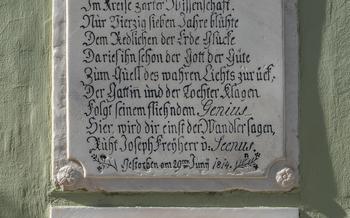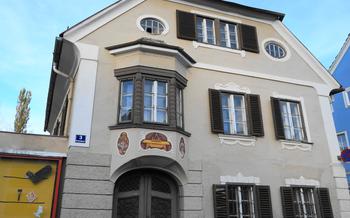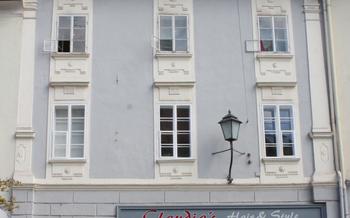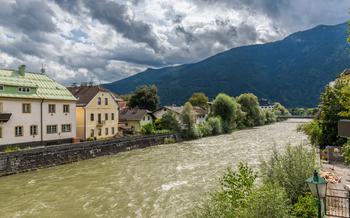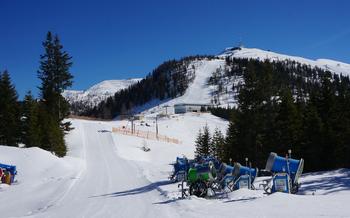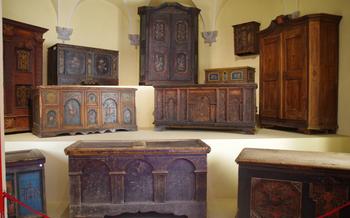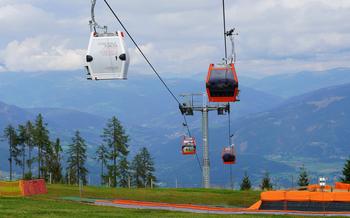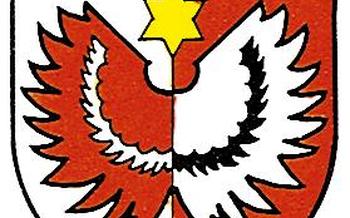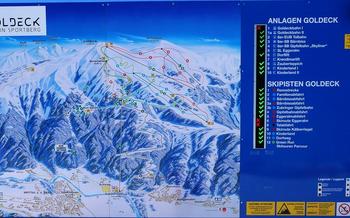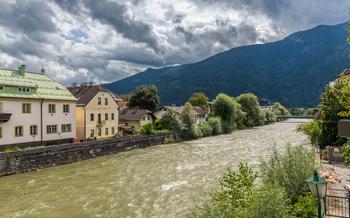
Landwirtschaftsmuseum Schloss Ehrental
- Landwirtschaftsmuseum Schloss Ehrental: A Historical Overview
- Exploring the Museum's Collection
- Thematic Sections of the Museum
- Agricultural Machinery and Tools
- Farming Techniques and Practices
- Animal Husbandry
- Crops and Cultivation
- Forestry and Sustainable Land Management
- Workshops and Educational Programs
- Special Events and Exhibitions
- Surrounding Attractions
- Getting There
- Opening Hours and Admission Fees
- Guided Tours
- Insider Tip
Landwirtschaftsmuseum Schloss Ehrental: A Historical Overview
The Landwirtschaftsmuseum Schloss Ehrental is a unique and fascinating museum dedicated to the history and development of agriculture in Austria. Housed within the picturesque walls of Schloss Ehrental, a former Renaissance castle, the museum takes visitors on a journey through the centuries, showcasing the rich agricultural heritage of the region.
The castle's transformation into a museum began in the early 20th century when it was acquired by the Carinthian Agricultural Society. Recognizing the importance of preserving and promoting the region's agricultural traditions, the society set about creating a museum that would tell the story of farming in Carinthia and beyond.
Over the years, the Landwirtschaftsmuseum Schloss Ehrental has grown and evolved, becoming a nationally recognized institution dedicated to Austrian agricultural history. Its extensive collection of artifacts, interactive exhibits, and educational programs provide visitors with a comprehensive insight into the vital role that agriculture has played in shaping the culture and economy of Austria.
Exploring the Museum's Collection
Landwirtschaftsmuseum Schloss Ehrental offers a diverse collection of agricultural artifacts and machinery, providing visitors with a comprehensive insight into traditional farming practices and rural life in Austria. The museum's exhibits encompass a wide range of tools, equipment, and machinery used in various aspects of agriculture, from cultivation and harvesting to livestock breeding and forestry.
Visitors can explore the museum's collection to discover traditional farming techniques, such as hand-plowing, manual harvesting, and animal-powered machinery. The museum also features displays of modern agricultural technology, showcasing the evolution of farming practices over the years. From tractors and combines to precision farming equipment, the exhibits highlight the advancements that have revolutionized agricultural production.
The museum's collection also includes a variety of agricultural products, such as grains, fruits, and vegetables, which are displayed to showcase the diversity of crops grown in Austria. Visitors can learn about traditional crop cultivation methods, as well as modern agricultural practices aimed at increasing productivity and sustainability.
Overall, the Landwirtschaftsmuseum Schloss Ehrental's collection offers a fascinating journey through the history and evolution of agriculture in Austria, providing visitors with an opportunity to gain a deeper understanding of the country's rural heritage and the significance of agriculture in shaping its cultural identity.
Thematic Sections of the Museum
Landwirtschaftsmuseum Schloss Ehrental is divided into several thematic sections, each focusing on a different aspect of agriculture. These sections offer visitors a comprehensive overview of the history, practices, and technologies involved in farming in Austria.
One section of the museum is dedicated to traditional farming practices and rural life in Austria. Visitors can learn about the tools and techniques used by farmers in the past, as well as the challenges they faced. This section also features interactive exhibits that allow visitors to experience some of these traditional farming activities firsthand.
Another section of the museum focuses on agricultural machinery and technology. Here, visitors can see a wide range of farming equipment, from simple hand tools to modern tractors and combines. This section also traces the evolution of agricultural technology over the years, from the earliest plows to the latest precision farming equipment.
The museum also has a section dedicated to animal husbandry. This section features exhibits on various livestock breeds, as well as information on animal care and breeding practices. Visitors can learn about the importance of livestock in Austrian agriculture, as well as the different breeds of animals that are raised in the country.
In addition to these permanent exhibits, the museum also hosts temporary exhibitions on various topics related to agriculture. These exhibitions often feature the work of local farmers and agricultural organizations, and provide visitors with an opportunity to learn about new developments in the field.
Agricultural Machinery and Tools
Landwirtschaftsmuseum Schloss Ehrental offers a fascinating journey through the evolution of agricultural technology. Enter the museum's halls and be greeted by an impressive array of farming equipment, from rudimentary hand tools to state-of-the-art machinery. Witness the ingenuity and creativity of farmers throughout history as they sought to improve their efficiency and productivity.
Discover the simple yet effective tools that were once the backbone of Austrian agriculture, such as wooden plows, scythes, and flails. Each tool tells a story of hard work and dedication, showcasing the resourcefulness of farmers in adapting to their environment. As you move through the exhibits, you'll see how these traditional implements gradually gave way to more advanced machinery.
Marvel at the gleaming tractors, combines, and other modern marvels of agricultural engineering. Learn about the impact of mechanization on farming practices and the significant increase in productivity it brought about. Interactive displays and hands-on exhibits allow you to experience the operation of these machines and gain a deeper understanding of their role in modern agriculture.
From simple hand tools to sophisticated machinery, the Landwirtschaftsmuseum Schloss Ehrental provides a comprehensive overview of agricultural technology's evolution. It's a testament to the ingenuity and perseverance of farmers throughout history, who have continuously strived to improve their methods and increase their yields.
Farming Techniques and Practices
At the Landwirtschaftsmuseum Schloss Ehrental, visitors can delve into the fascinating world of traditional and modern farming techniques. Interactive displays and hands-on experiences bring to life the rich history of agriculture in Austria. Witness demonstrations of age-old farming practices, such as plowing with oxen, threshing grain with a flail, or making butter using a traditional churn. Learn about the challenges faced by farmers in the past and how they adapted to changing conditions.
The museum also showcases the evolution of modern agricultural practices. Discover the latest technologies and innovations that have revolutionized farming in recent decades. Interactive exhibits explain the science behind modern farming methods, such as precision agriculture, sustainable land management, and genetic engineering. Visitors can also see demonstrations of modern agricultural machinery in action, such as tractors, combines, and milking machines.
By exploring the farming techniques and practices section of the Landwirtschaftsmuseum Schloss Ehrental, visitors gain a deeper understanding of the vital role that agriculture has played in shaping Austrian society and culture. They come away with a newfound appreciation for the hard work and dedication of farmers, past and present, who have ensured that Austria remains a land of plenty.
Animal Husbandry
The Landwirtschaftsmuseum Schloss Ehrental dedicates a significant section to animal husbandry, providing visitors with a comprehensive insight into the world of livestock farming in Austria. Interactive exhibits and informative displays showcase various livestock breeds, including cattle, pigs, sheep, and horses, highlighting their unique characteristics and significance in agriculture.
The museum's collection features historical and contemporary farming practices, allowing visitors to trace the evolution of animal husbandry techniques over time. Learn about traditional breeding methods, animal care practices, and the importance of livestock in sustaining rural communities.
A highlight of the animal husbandry section is the opportunity to witness live demonstrations of traditional farming tasks, such as milking cows or shearing sheep. These demonstrations provide a glimpse into the daily lives of farmers and the essential role they play in ensuring a sustainable food supply.
The museum also addresses modern challenges and innovations in animal husbandry, such as selective breeding, artificial insemination, and precision livestock farming. Visitors can explore how these advancements are transforming the industry and contributing to increased efficiency and productivity.
Whether you're a seasoned farmer or simply curious about the world of animal husbandry, the Landwirtschaftsmuseum Schloss Ehrental offers a wealth of knowledge and hands-on experiences that will deepen your understanding and appreciation for this vital aspect of Austrian agriculture.
Crops and Cultivation
The museum's section on crops and cultivation offers a comprehensive overview of traditional and modern farming methods in Austria. Visitors can learn about the history of crop cultivation in the region, from ancient grains to modern hybrid varieties. Interactive displays showcase the different stages of crop growth and development, from seed selection to harvesting.
Exhibits highlight the importance of crop rotation, soil management, and irrigation techniques in sustainable agriculture. Visitors can see examples of traditional farming tools, such as plows, scythes, and threshing machines, as well as modern machinery used for planting, harvesting, and processing crops.
The museum also features a section on crop diversity, with displays of various types of grains, fruits, and vegetables grown in Austria. Visitors can learn about the unique characteristics and uses of different crops, as well as the challenges faced by farmers in adapting to changing climatic conditions.
Overall, the Crops and Cultivation section provides a fascinating glimpse into the world of Austrian agriculture, showcasing the rich heritage and innovation that have shaped the country's farming practices over the centuries.
Forestry and Sustainable Land Management
Austria's forests play a crucial role in the country's environment and economy. The Landwirtschaftsmuseum Schloss Ehrental dedicates a significant section to forestry, showcasing the importance of sustainable land management practices. Visitors can learn about the various types of forests found in Austria, their ecological significance, and the impact of forestry on the environment. Interactive exhibits demonstrate the sustainable harvesting of timber, reforestation efforts, and the role of forests in mitigating climate change. The museum also highlights the importance of agroforestry, a practice that integrates trees and crops on the same land, to enhance biodiversity and soil fertility. Through its forestry exhibits, the museum promotes responsible forest management and encourages visitors to adopt sustainable land practices in their own communities.
Workshops and Educational Programs
The Landwirtschaftsmuseum Schloss Ehrental offers a range of educational programs and workshops to enhance visitors' understanding of agriculture. These programs are designed for both individuals and groups, catering to different age groups and interests.
At the museum's workshops, visitors can engage in hands-on activities that bring traditional farming practices to life. Participants can learn about wool spinning, butter churning, and other traditional skills that were once essential to rural life in Austria. These workshops provide a unique opportunity to experience the challenges and rewards of traditional farming methods firsthand.
For schools and educational groups, the museum offers guided tours and educational programs that align with school curricula. These programs introduce students to the history of agriculture, farming techniques, and the importance of sustainable land management. Interactive exhibits and hands-on activities make learning about agriculture fun and engaging for students of all ages.
Whether you're an individual looking to deepen your knowledge of traditional farming or an educator seeking to bring agriculture to life for your students, the Landwirtschaftsmuseum Schloss Ehrental's educational programs offer a valuable and enriching experience.
Special Events and Exhibitions
The Landwirtschaftsmuseum Schloss Ehrental hosts a variety of special events and exhibitions throughout the year, offering visitors a chance to engage with experts, participate in discussions, and experience agriculture in new and exciting ways. These events often coincide with seasonal holidays or agricultural festivals, providing a unique opportunity to immerse in the region's farming traditions and heritage.
One of the most popular events is the annual "Erntefest" (Harvest Festival), held in September to celebrate the end of the harvest season. Visitors can witness traditional harvesting techniques, sample local produce, and participate in family-friendly activities like pumpkin carving and hay bale stacking.
The museum also organizes temporary exhibitions on specific agricultural topics, showcasing innovations in farming technology, sustainable practices, or the history of agriculture in the region. These exhibitions often feature interactive displays, multimedia presentations, and hands-on experiences that allow visitors to learn about agriculture in a fun and engaging way.
Whether you're a seasoned farmer or simply curious about the world of agriculture, the Landwirtschaftsmuseum Schloss Ehrental's special events and exhibitions offer a unique opportunity to connect with the region's farming heritage, engage with experts, and gain new insights into the importance of agriculture in our daily lives.
Surrounding Attractions
Spittal an der Drau is a charming town with several attractions that complement a visit to the Landwirtschaftsmuseum Schloss Ehrental. For history enthusiasts, the Spittal Castle is a must-see, with its medieval architecture and fascinating exhibits on the region's past. Art lovers will appreciate the Museum of Modern Art, showcasing contemporary works from local and international artists.
Nature lovers can explore the beautiful Drau Valley, known for its stunning landscapes and hiking trails. Take a leisurely stroll along the riverbanks, admire the panoramic views from the nearby mountains, or embark on a cycling adventure through the picturesque countryside.
For a unique cultural experience, visit the Heimatmuseum Spittal, which offers insights into the town's rich traditions and heritage. You can also immerse yourself in the local cuisine at one of the many traditional restaurants, serving delicious Carinthian specialties.
When planning your visit to Spittal an der Drau, consider combining it with a trip to the Millstatt Abbey, a historic Benedictine monastery with breathtaking architecture and a fascinating history. The nearby Lake Millstatt is a popular destination for water sports enthusiasts, offering swimming, sailing, and fishing opportunities.
To make the most of your time in Spittal an der Drau, plan a comprehensive itinerary that includes a visit to the Landwirtschaftsmuseum Schloss Ehrental, exploring the town's attractions, and indulging in the region's natural beauty.
Getting There
The Landwirtschaftsmuseum Schloss Ehrental is conveniently located in Spittal an der Drau, Austria, making it easily accessible by car or public transportation.
By Car:
- From the A10 Tauern Autobahn, take exit 149 (Spittal/Millstätter See) and follow the signs for Spittal an der Drau.
- Once in Spittal, follow the signs for the Landwirtschaftsmuseum Schloss Ehrental, which is located on the outskirts of the city.
- Ample parking is available on-site for visitors arriving by car.
By Public Transportation:
- Take a train to Spittal an der Drau train station, which is well-connected to major cities in Austria and neighboring countries.
- From the train station, take bus line 5115 towards Lendorf and get off at the "Landwirtschaftsmuseum Schloss Ehrental" stop.
- The bus stop is located right in front of the museum entrance, making it easy to reach on foot.
Whether you choose to drive or take public transportation, getting to the Landwirtschaftsmuseum Schloss Ehrental is a breeze. Once you arrive, you'll be greeted by the stunning sight of the castle and the beautiful surroundings, setting the stage for an unforgettable visit.
Opening Hours and Admission Fees
Landwirtschaftsmuseum Schloss Ehrental is open to the public from Tuesday to Sunday, 10am to 5pm. The museum remains closed on Mondays and on public holidays.
Admission fees are as follows:
- Adults: €7
- Seniors (60+): €5
- Students (with valid ID): €3
- Children (6-15): €2
- Families (2 adults and 2 children): €15
Guided tours are available in German and English and are subject to an additional fee of €2 per person. Tours can be booked in advance by contacting the museum directly.
The museum offers discounted rates for groups of 10 or more and special offers for families and schools. Please inquire about group rates and educational programs when booking your visit.
Guided Tours
The Landwirtschaftsmuseum Schloss Ehrental offers guided tours in German and English, providing visitors with a deeper insight into the history, exhibits, and significance of the museum. These tours are led by knowledgeable guides who are passionate about agriculture and its history. Advance booking is recommended for groups, especially during peak tourist season.
During the guided tours, visitors will learn about the evolution of farming practices in Austria, the various agricultural machinery on display, and the importance of sustainable land management. Guides will also share stories and anecdotes related to the exhibits, bringing the museum's collection to life.
Whether you're a history buff, a lover of agriculture, or simply looking for a unique and educational experience, a guided tour of the Landwirtschaftsmuseum Schloss Ehrental is highly recommended. It's an opportunity to gain a deeper understanding of Austrian agricultural heritage and its impact on the country's culture and landscape.
Insider Tip
The best time to visit the Landwirtschaftsmuseum Schloss Ehrental is during the summer months (June to August) when the surrounding gardens and fields are in full bloom, offering a picturesque backdrop for the museum's exhibits. Plan to spend at least half a day exploring the museum and its grounds, allowing ample time to immerse yourself in the interactive displays and hands-on activities.
For an unforgettable experience, time your visit to coincide with one of the museum's special events or temporary exhibitions. These events often feature demonstrations of traditional farming techniques, workshops on rural crafts, and opportunities to meet local farmers and experts in the field of agriculture. Embrace the chance to engage in lively discussions and gain valuable insights into the challenges and rewards of modern-day farming.
While exploring the museum, keep an eye out for hidden gems tucked away in various corners. Discover the charming collection of vintage tractors and agricultural machinery, marvel at the intricate carvings and decorations adorning the castle's exterior, and seek out the panoramic viewpoint offering breathtaking views of the surrounding countryside. Don't forget to capture these special moments with your camera to cherish lasting memories of your visit to the Landwirtschaftsmuseum Schloss Ehrental.
